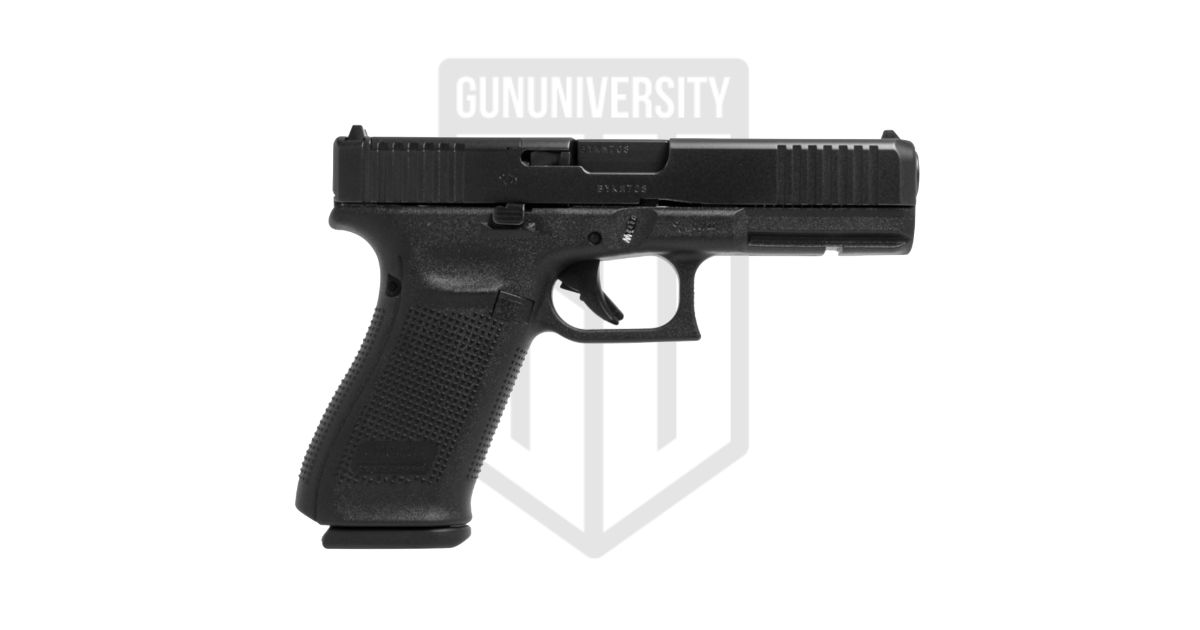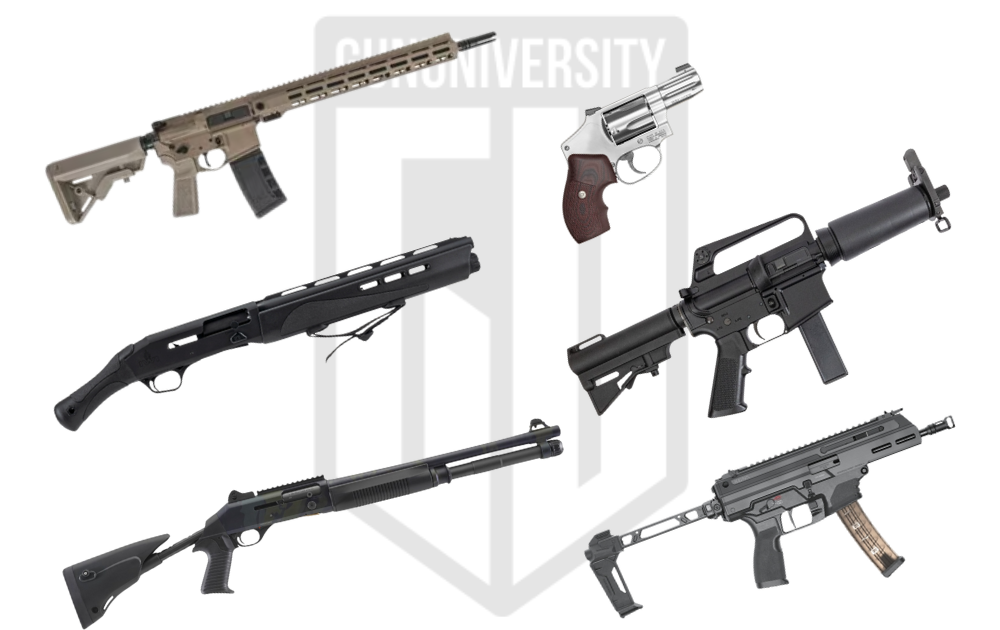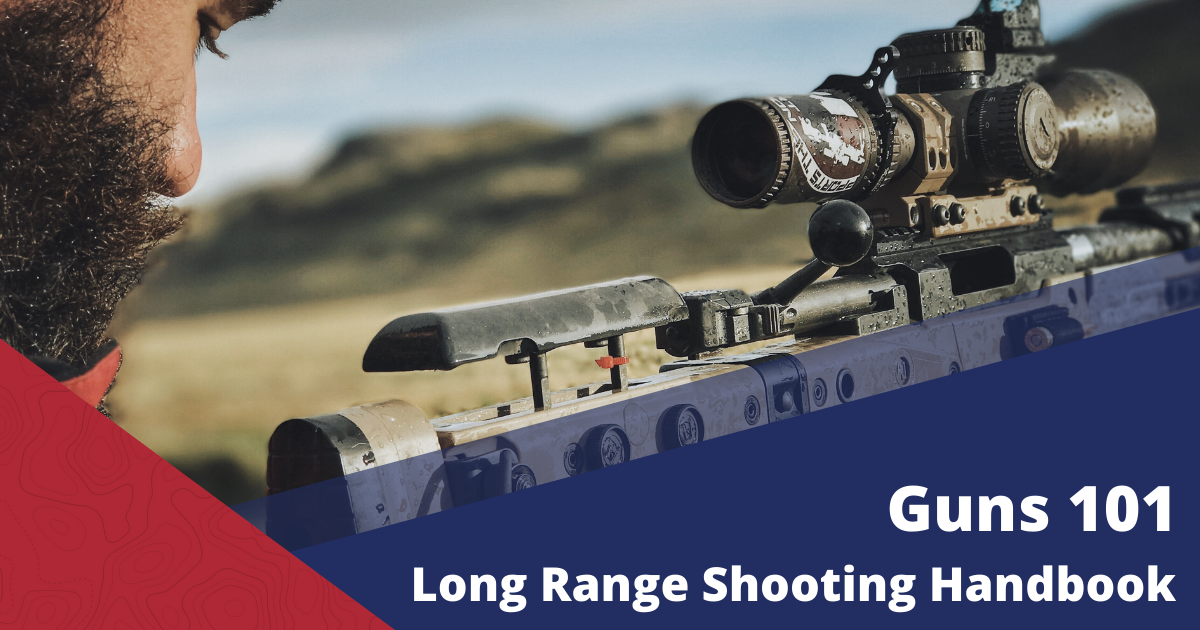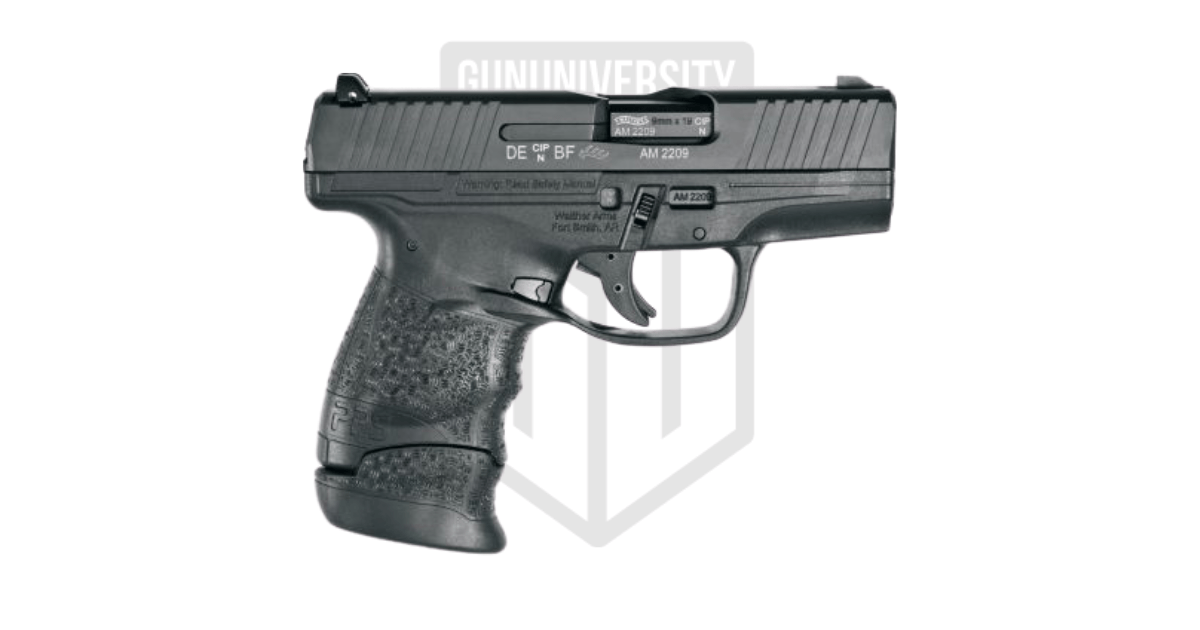.357 Magnum vs. 10mm Auto: Old School vs. New School in Magnum Power
Every action triggers an equal and opposite reaction. When you pursue man-portable power, a long gun reigns supreme. Rifles and shotguns launch larger payloads at higher velocities than any conventional handgun round. Handguns, designed for compact manageability, typically don’t chamber such potent rounds. Even if possible, carrying or shooting such a handgun proves impractical.
Handgun rounds are inherently less powerful. They lack the flat trajectory, high velocity, and terminal ballistics of rifle rounds. Yet, some handgun cartridges tackle bigger jobs. Certain rounds effectively penetrate barriers and deter both two-legged and four-legged predators. The .357 Magnum and 10mm Auto stand out as two popular handgun rounds excelling in these roles.
The .357 Magnum and 10mm Auto cartridges lead three distinct lives: in law enforcement, personal protection, and as wilderness tools. Your preference often hinges on your choice between a revolver for the .357 or an autoloading pistol for the 10mm. However, these two cartridges share more similarities and differences than you might expect. This overview explores the .357 Magnum and 10mm Auto, examining both their historical context and their current utility as defensive tools.
357 Magnum vs. 10mm Auto Spec Comparison

357 Magnum
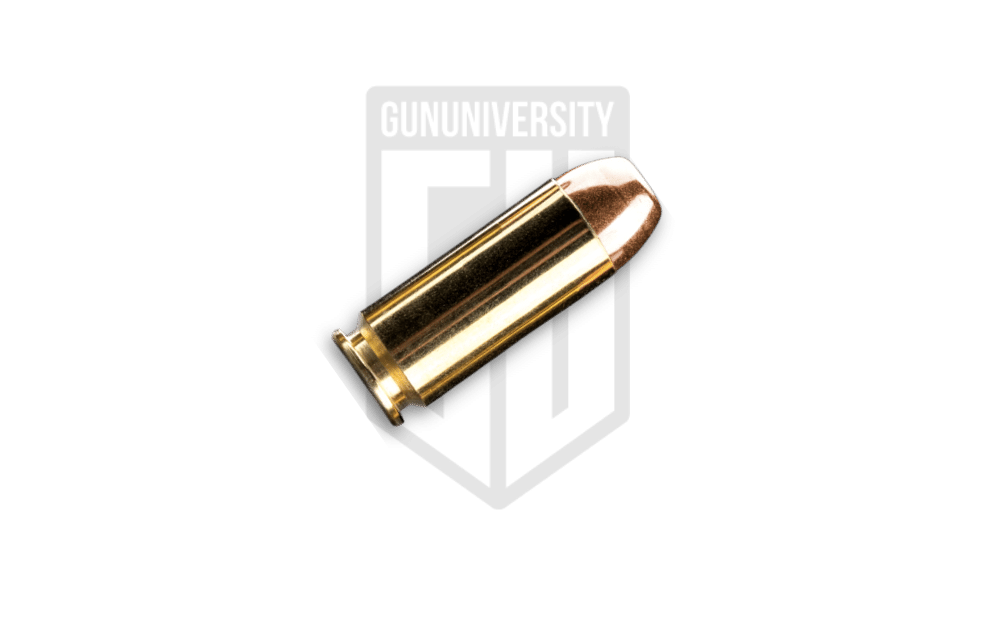
10mm Cartridge
Why Compare the .357 Magnum and 10mm?
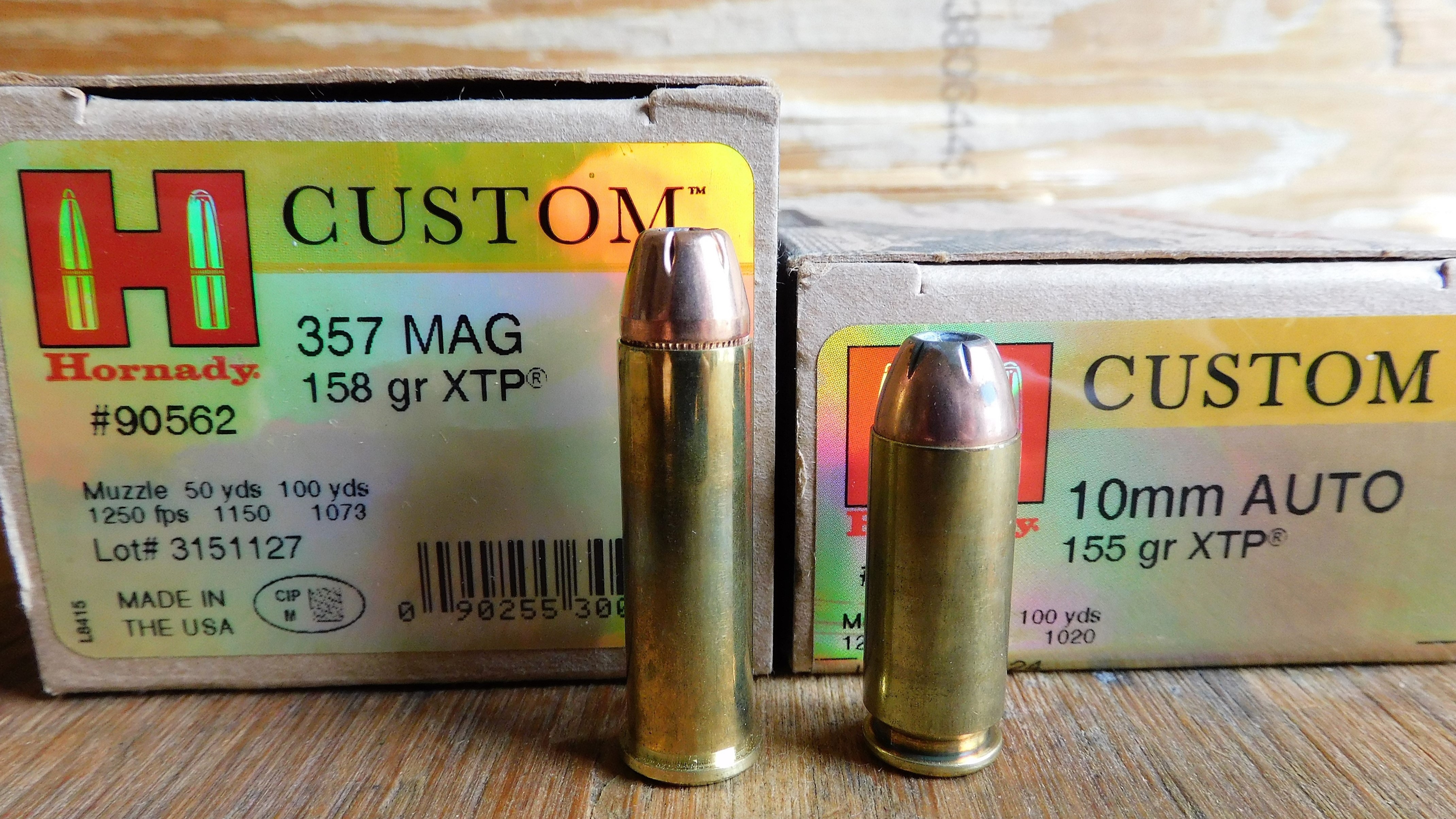
If you’re looking for a powerful, capable handgun cartridge that’s not in the big bore category, you’ll find yourself deciding between .357 Magnum and 10mm. Both rounds provide significant performance beyond typical self-defense calibers, making them suitable for wilderness defense, hunting, and even law enforcement duties.
While their ballistic profiles often overlap, and they can achieve similar results, they differ vastly. The .357 Magnum, a rimmed cartridge, thrives in revolvers, known for its venerable history and broad range of bullet weights. In contrast, the rimless 10mm Auto excels in higher-capacity semi-automatic pistols, appealing to those who want more rounds at the ready.
It’s easy to say the decision between the two comes down to the personal preference between revolvers or automatics, and while that plays a big role, it’s not the full story. A deeper look reveals nuances in recoil characteristics, cartridge versatility, penetration capabilities, and ammunition availability.
Understanding these differences allows shooters to make informed choices based on their specific needs and desired applications. The good news is that either cartridge offers you a formidable personal defense round capable of dealing with a massive variety of threats.
The .357 Magnum: The Original
The roaring twenties are long gone, prohibition’s in full swing, and gangsters are zipping around in cars, laughing at the puny .38 Specials cops were lugging. Law enforcement needed a tool, something that could penetrate sheet metal and neutralize armed threats. Enter three legends of the revolver world: Elmer Keith, Philip Sharpe, and Doug Wesson from Smith & Wesson. These three had taken a hard look at the .38 Special and decided that it left a lot to be desired. The cartridge had a significant amount of case capacity remaining.
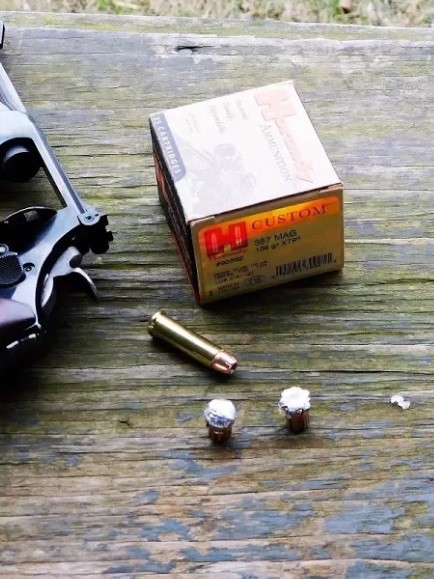
If you start adding a little extra powder to the case of the .38 Special, you’ve increased its power. This increased projectile velocity, which allowed it to punch through the bodies of cars and hit those car-based bandits. The .38 Special has been around for a long time, and there were lots of .38 Special guns floating around.
To prevent these hot-loaded roads from being loaded in guns not built to handle them, they lengthened the case 1/8th of an inch. This prevents the cartridge from fitting in .38 Specials and prevents firearms from exploding. This brilliant, yet simple, move ensured that only purpose-built, beefed-up revolvers could handle the severe heat this new cartridge was packing.
When the .357 Magnum officially dropped in 1935, it hit like a thunderclap. Suddenly, police departments had a genuine sledgehammer in their holsters. This wasn’t just about stopping a human threat; it was about stopping armed threats hiding behind cover. It has evolved to include taking on four-legged threats as well.
It became the gold standard for powerful fighting handgun performance. Decades later, the .357 Magnum remains a testament to its raw, unadulterated power and enduring legacy.
Find out what our favorite 357 Magnum revolvers are!
.357 Magnum Pros and Cons
- High Ballistic Coefficient – With loadings of identical weight, the smaller diameter .357 Magnum will have a longer bullet, or higher ballistic coefficient, than the .40 caliber bullet of the 10mm. This yields better long range wind and drop resistance and better penetration.
- Availability – The .357 Magnum is the most available magnum cartridge out there. Load variety is also plentiful.
- Power Potential – With its larger case capacity, the .357 Magnum can be loaded hotter than the 10mm, although it usually is not.
- Rounds Limited – Most .357 Magnum handguns are revolvers with capacities of 5-8 rounds.
- Light-Grained – Most available ammunition range between 125-158 grain.
Great .357 Magnum Ammo
Here are some of our favorite ammo deals for .357 Magnum.
Hunting Ammo
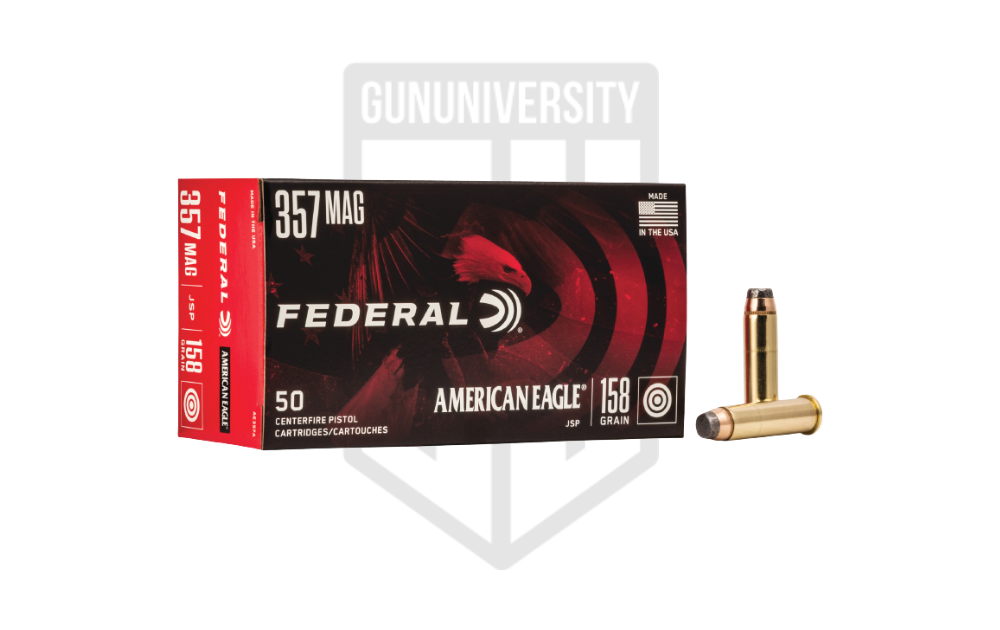
Federal 158 grain JSP
- Original 1930s load
- Inexpensive
- Flat lead soft-point for uniform penetration and expansion in game
Marketplace |
Cost |
| Gun.deals | |
| Brownells | |
| Target Sports USA |
Defensive Ammo
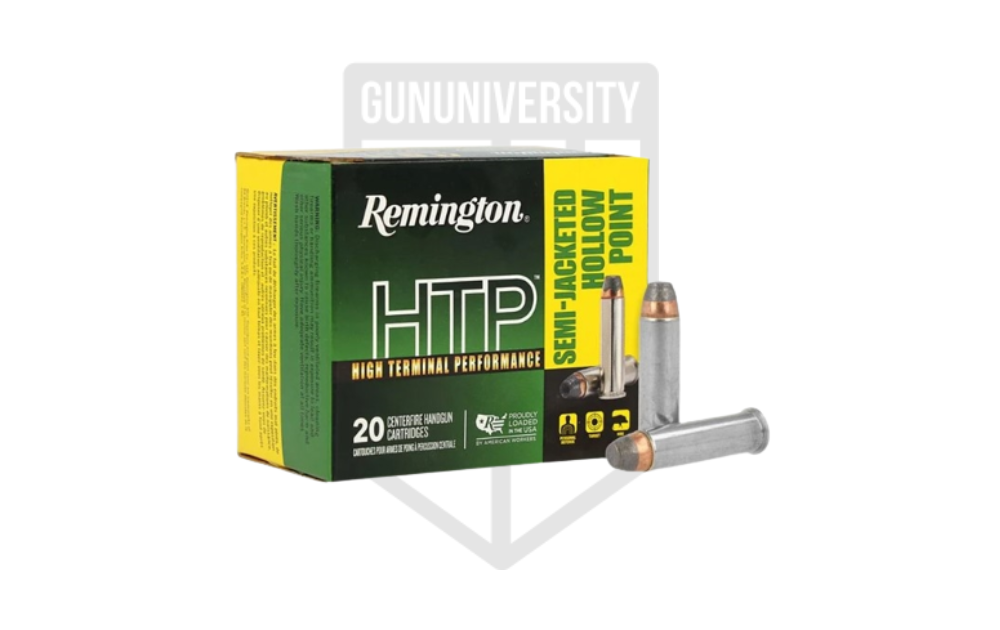
Remington HTP 125 grain JHP
- A popular law enforcement option
- Over 1400 feet per second out of a four-inch barreled revolver
- Standard of measure for other defensive handgun cartridges
Marketplace |
Cost |
| Gun.deals | |
| Target Sports USA | |
| Natchez |
The 10mm Auto: Magnum Power in a New Pistol
If the .357 Magnum was the hammer, the 10mm Auto was designed to be a scalpel with a sledgehammer’s punch. Its story begins not with law enforcement trying to catch gangsters, but with a legend in the firearms world named Jeff Cooper. Cooper. Colonel Cooper was a .45 ACP fan. He liked the .45 ACP but felt it lacked the flatter trajectory and energy retention he desired for a serious combat handgun. He envisioned a semi-automatic cartridge that hit harder and flew straighter.
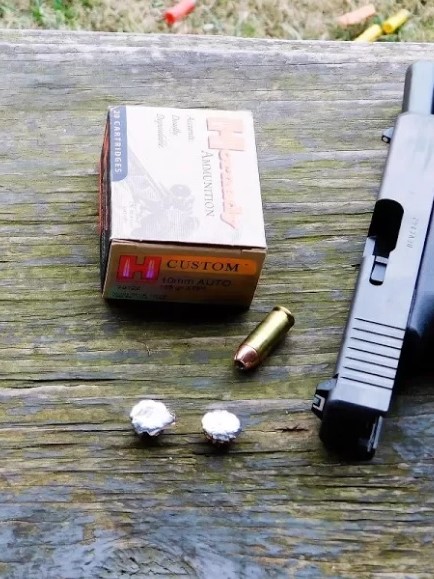
This quest for ballistic superiority led Cooper and some knowledgeable ballisticians to experiment. They found that a.40 caliber bullet in a lengthened .30 Remington case met the. The goal was to outclass both the 9mm Luger and the .45 ACP, delivering significant energy downrange while still fitting into a manageable semi-automatic platform. The resulting 10mm Auto was a powerhouse. From a full-sized handgun, it launched heavy projectiles at impressive velocities. This led to excellent penetration, expansion, and in a semi-auto, it gave excellent capacity.
The 10mm’s initial journey was rocky. It was introduced in 1983 with the much-hyped Bren Ten pistol. While the Bren Ten gained cult status thanks to its appearance on Miami Vice, it was plagued by production issues, quality control problems, and a frustrating lack of magazines.
The 10mm’s raw power caught the eye of the FBI after the infamous 1986 Miami shootout. This tragic shooting highlighted the need for more effective law enforcement cartridges.
Though the FBI eventually adopted a 10mm lite cartridge to deal with the excess recoil, this 10mm lite led to the creation of the .40 S&W. The FBI’s brief endorsement cemented the 10mm’s reputation. Today, the 10mm has experienced a resurgence, cherished by handgun hunters, wilderness enthusiasts, and those who simply appreciate a cartridge that doesn’t pull any punches.
Here is a list of our top 10mm handguns. We also have what might be our new favorite 10mm handgun review.
Glock 20 Glock 20 Gen 5 MOS
Glock 20 Gen 5 MOS
The latest update of the pistol that’s been revolutionizing the world since the late ’80s and bringing the 10mm into mainstream
- Shootability A
- Reliability A+
- Ergonomics A
- Accuracy A
- Value A
Our Grade
A
Reader’s Grade
A
Based on 35 Reviews
Your Grade
Do You Own This Handgun? Leave A Review
Success Your Grade Has Been
Added To Our Reader’s Score
We use email to verify the accuracy of our reviews. We promise to never spam you.
10mm Auto Pros and Cons
- More Mass – The 10mm Auto, on the whole, will be loaded with a heavier-grained and wider .40 caliber projectile. Those who favor bullets with mass will be more satisfied with the 10mm.
- Short and Rimless – Although its 25mm case length is long for a pistol cartridge, the 10mm is shorter than ordinary magnum rounds and it is rimless, allowing for smooth feeding in an autoloading pistol.
- Auto Loading – Attempts at a .357 Magnum autoloader are not nearly as reliable.
- Underloading – The 10mm Lite round was a phase of development that should have died with the .40 S&W round. Many factory offerings for the 10mm are, in fact, loaded to .40 S&W specifications and not to their full potential.
- Availability – Despite its resurgence, 10mm handguns and ammunition are not as available as the .357 Magnum.
Great 10mm Ammo
Here are some deals on our favorite 10mm ammo.
Hunting Ammo
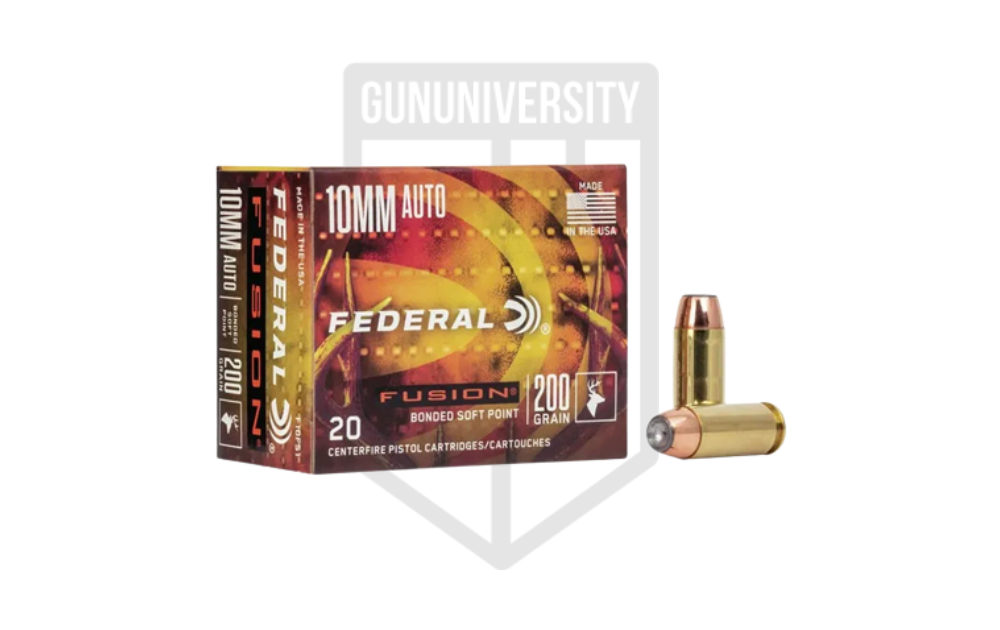
Federal Fusion 200 grain Bonded Soft Point
- bonded soft-point bullet for maximum weight retention and controlled expansion
- loaded to 1200 feet per second
Marketplace |
Cost |
| Gun.deals | |
| Brownells | |
| Palmetto State Armory |
Defensive Ammo
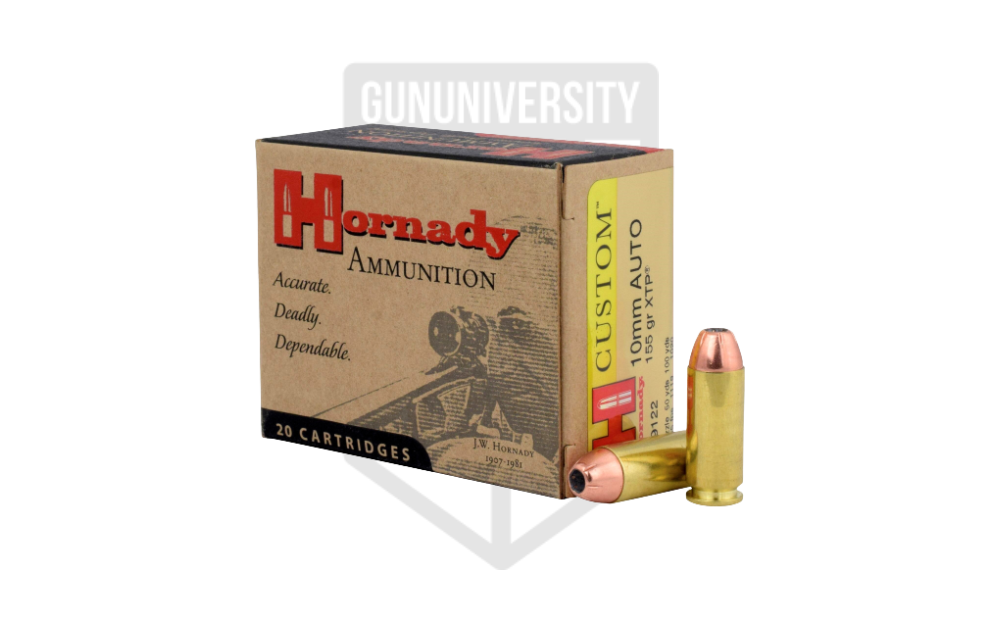
Hornady Custom 155 grain JHP
- light XTP hollow-point for clothing-blind performance on target
- penetrates upwards of nineteen-inches in 10% ordinance gelatin
Marketplace |
Cost |
| Gun.deals | |
| Sportsmans Guide | |
| Optics Planet |
.357 Magnum vs 10mm Ballistic Comparison
The 10mm Auto, as Norma originally loaded it, is continually touted as a semi-auto equivalent to the .41 Magnum revolver cartridge. Both are .40 caliber rounds using 200 grain bullets, traveling at about 1200 feet per second. The comparison is somewhat misplaced, however. The .41 Magnum, when it was introduced in 1964, suffered much of the same fate as the 10mm years later. They envisioned the .41 as a 210 grain bullet traveling at 1400 feet per second, but they downloaded it for commercial use. When loaded to their full potential, the 10mm’s velocity and energy territory overlap more with the .357 than it does the .41.
By the numbers, the 10mm Auto can chuck a 200-grain bullet at about 1200 feet per second out of a typical five-inch barreled autoloader. A four-inch barreled revolver can expect to yield upwards of 1500 feet per second using a 125-grain bullet. In terms of energy foot pounds, the 10mm yields 639 foot pounds of energy. The .357 gives us 625. That is not enough difference to talk about, but what is worth noting is how that energy is transferred. The lighter-grained .357 with its higher velocity will have excellent terminal performance but may not go very far through dense bone and the thick muscle of larger animals like the heavier 10 will. But ordinary 10mm loads loaded to their potential might be too much for thinner targets.
In my own testing using a 4-inch Smith & Wesson Model 27 and a 3 ¾ inch Glock 29, I shot a few different hollow-point and non-expanding projectiles and found that the .357’s penetrating ability goes up with grain size as expansion goes down, while the 10mm penetrates less with lighter projectiles. Buffalo Bore loads the .357 and 10mm Auto to their maximum potential in their Outdoorsman line of hard-cast semi-wadcutter loadings. In the Model 27, I could post the .357 Magnum 180 grain load at an honest 1400 feet per second over my chronograph. The Glock 29 has a slightly shorter barrel, but the 220 grain 10mm load’s velocity clocked in at only 1100 feet per second. The energy foot pounds between them were close, but the .357 Magnum had more energy foot pounds and its higher ballistic coefficient gave it a few more inches of penetrating power through ballistic gel and 2×4 barriers.
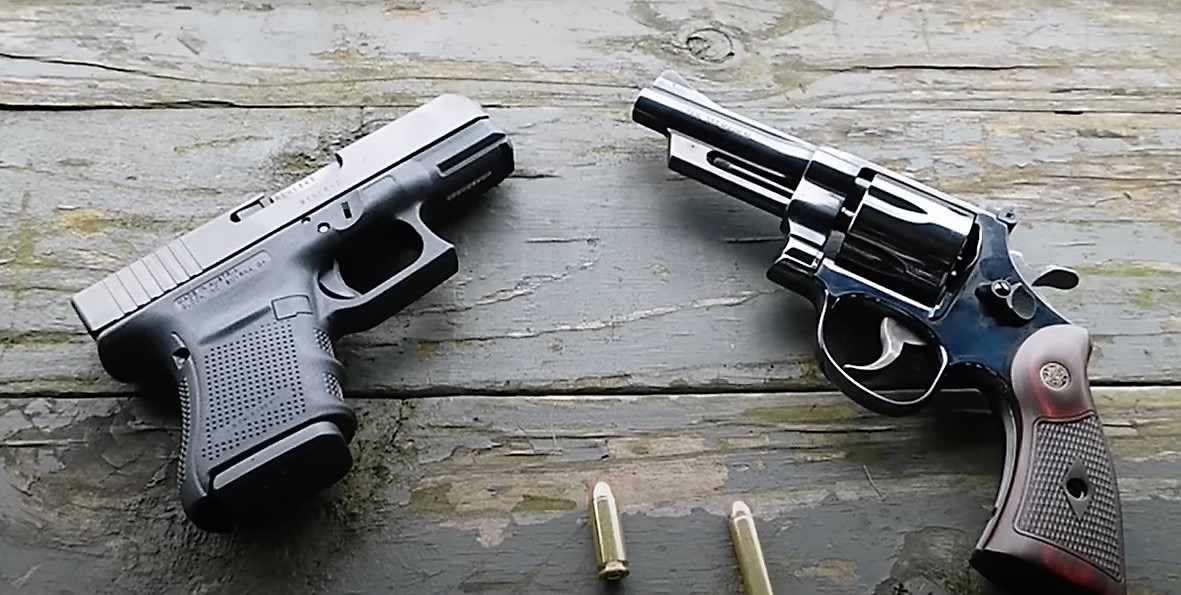
When maxed out, the .357 Magnum is marginally more powerful, but both the .357 and the 10mm cartridges themselves are not the full story. Gear selection matters to get the most out of each round and each will have their own advantages. The 10mm Auto is now chambered in a few revolvers but its primary advantage is in an autoloader platform. My Glock 29 is a subcompact 10mm that holds ten rounds of ammunition. That Model 27 .357 holds six rounds. A conventional 10mm pistol like the Glock 20 will hold fifteen rounds, while the newest .357s can hold eight in their cylinder. Although a quality revolver is less prone to user-induced malfunctions, both platforms have their issues. A 10mm Auto depends on the power level and bullet profile of the round in question to cycle reliably. Primers in some .357 Magnum loads can back out against the recoil shield of a revolver, freezing the cylinder up on firing.
10mm revolvers like the Smith & Wesson 610 and Ruger Match Champion exist but rely on fragile moon clips to eject the rimless ammunition. Likewise, .357 Magnum autoloaders exist, but I have yet to meet one that works correctly.
Barrel length and pistol size also comes into play. The revolver has the advantage of having a greater effective barrel length. A round coming from a .357 Magnum revolver with a 4-inch barrel will have 4 inches of barrel travel. A hypothetical 4-inch 10mm pistol will have less barrel travel as we count the chamber in barrel length. We can also have the revolver in smaller, lightweight packages like a snub nose J-frame like the Smith & Wesson Model 360 or the Ruger LCR. But these guns sacrifice ballistic potential and are obnoxious to shoot, as are the few small 10mm pistols around like my G29. A mid-size or large frame revolver or autoloader in either caliber is not obnoxious to shoot, although recoil and blast will be greater than typical pistol calibers.
Our Take
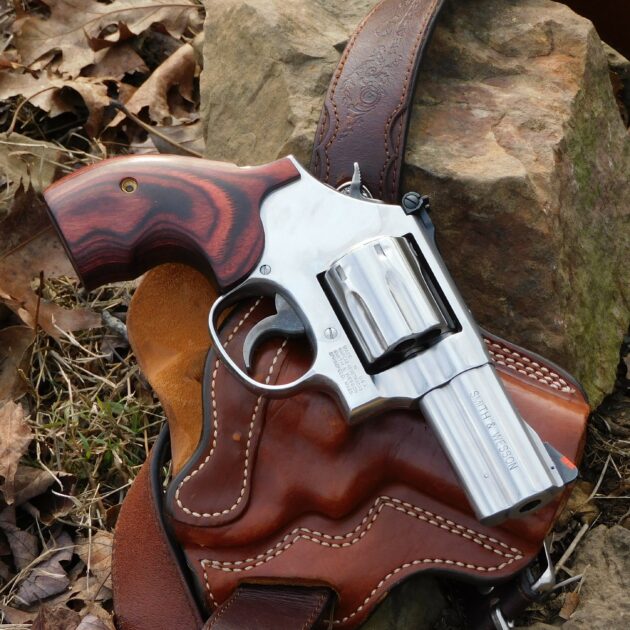
The .357 Magnum and 10mm Auto are two of the most useful handgun cartridges out there. Both are proven against lethal two-legged threats as well as the largest North American big game. But that extra power comes at a price. Over more conventional options, .357 and 10mm handguns and ammunition are more expensive and a bit less available. Recoil and blast from both rounds is not onerous, but both are certainly not great for the new shooter. Indeed, some loadings can be too powerful, even for the pistol in question. But if you are willing to work with either round, they will serve you well and much of the particulars of the caliber and load of your choice is going to be dictated by your preference for the revolver over the autoloader.
All I will say to that is to go for what you know. I have more trigger time with revolvers, know their limitations, and like the slight edge the .357 Magnum can have over the 10mm. I also like the ability to use lower-recoil .38 Special ammunition if I so choose. But if you already own an autoloader, a quality 10mm 1911, Glock, or Sig is right up your ally and just as capable of the bigger tasks. But if you ever get the chance, check out both.
Recent Posts
December 20, 2025
December 15, 2025
December 15, 2025
December 12, 2025

